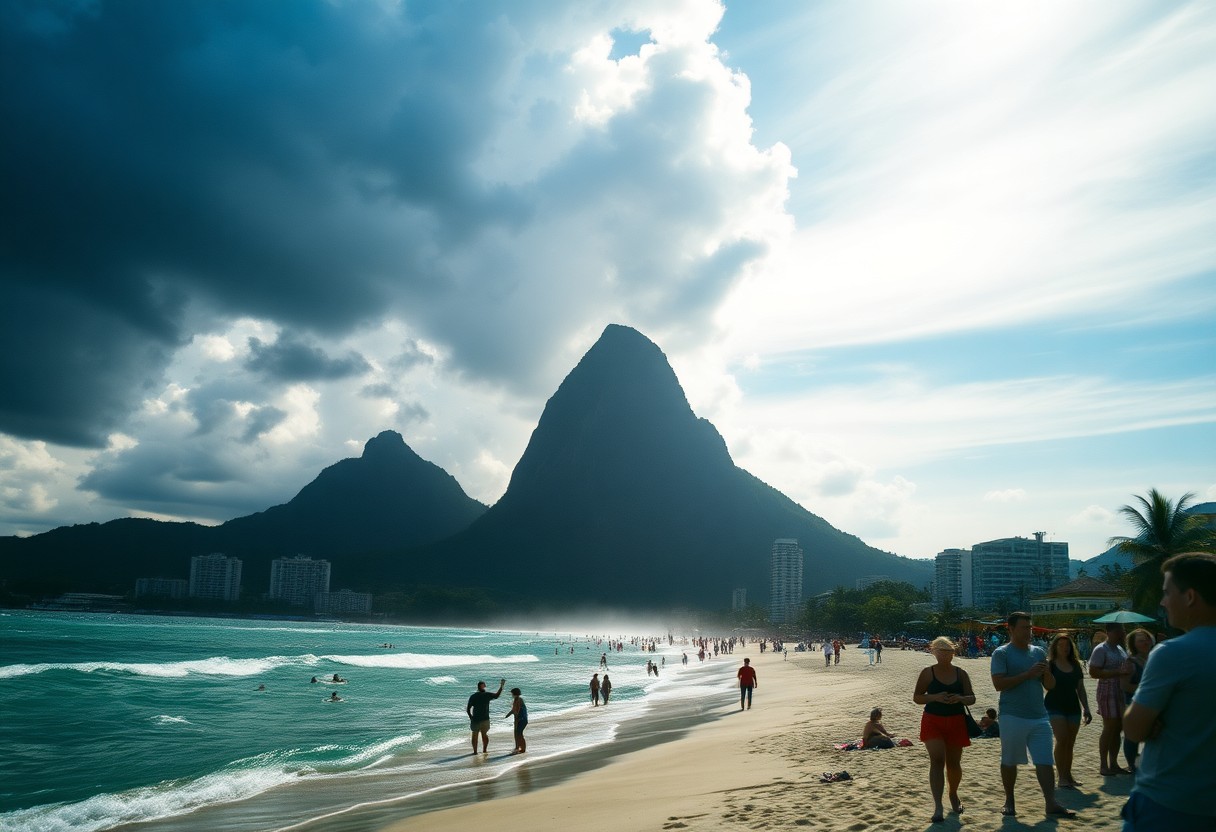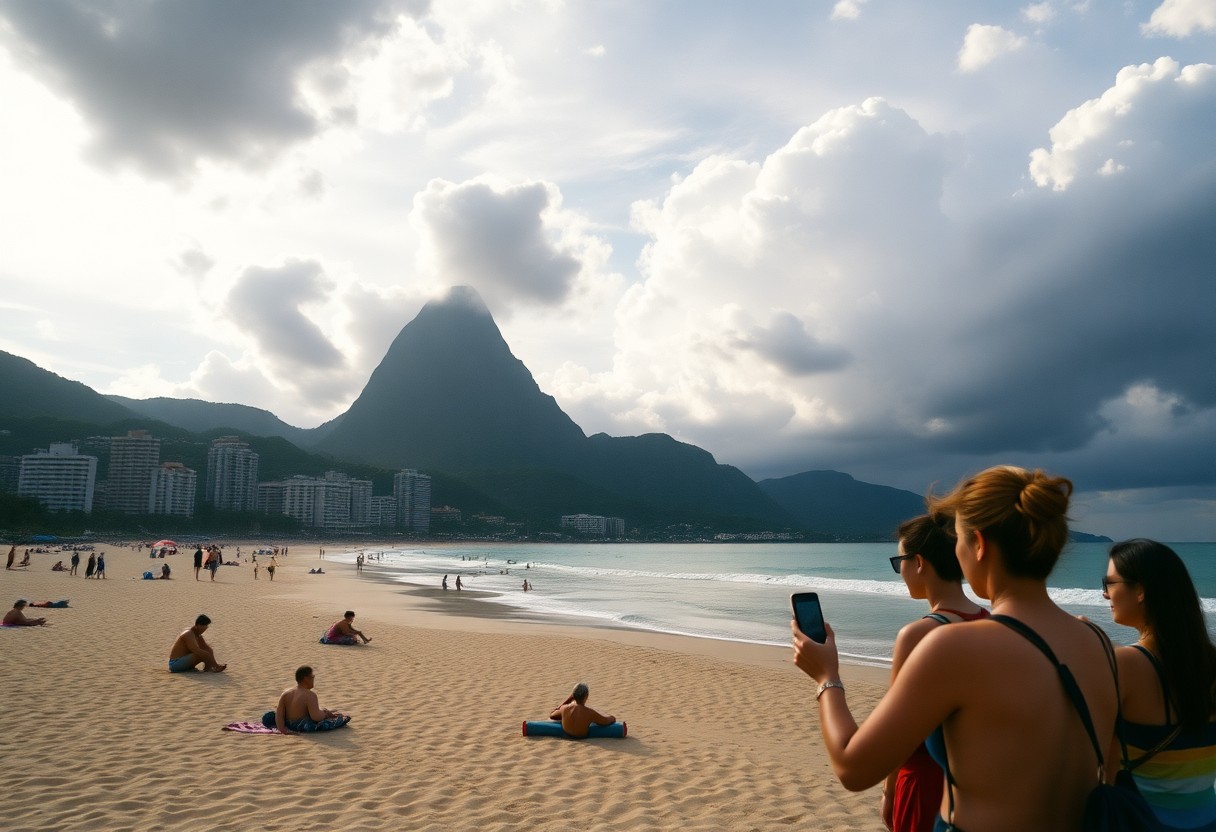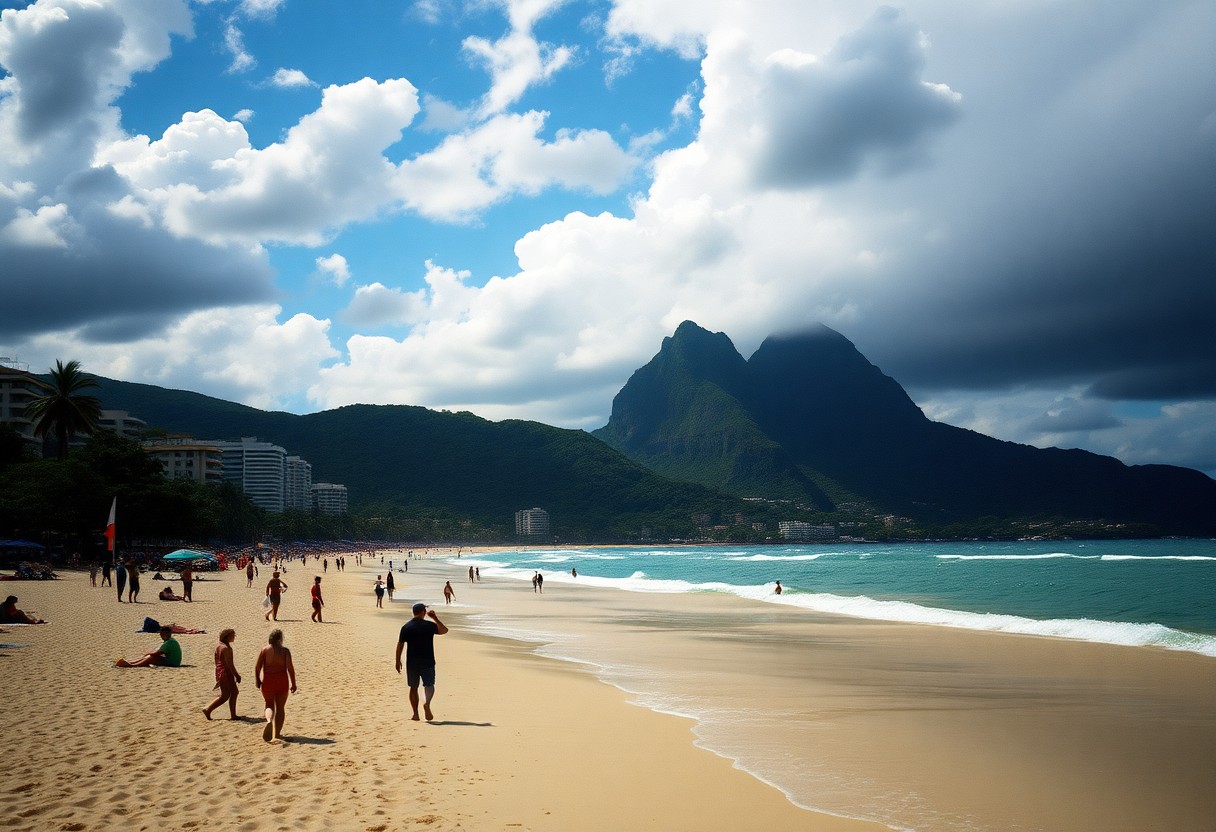As you plan your exciting journey to Rio de Janeiro, knowing the best times to visit can significantly enhance your overall experience. The city enjoys warm temperatures year-round, but each season brings distinct characteristics that can impact your travel decisions. The vibrant summer months, from December to March, are alive with colorful Carnival festivities, yet they also bring heavy rainfall and large crowds. Your ideal travel period will be largely influenced by your personal interests: if you love sunbathing and beach activities, then the spring months of September to November are ideal, featuring mild temperatures and fewer tourists. Conversely, budget-conscious travelers may prefer winter (June to August) for its more economical options. By syncing your travel plans with the local climate and seasonal events, you can greatly enhance your enjoyment during your stay in Rio.
Explore Rio de Janeiro’s Distinctive Weather Characteristics
Before you finalize your travel itinerary to Rio de Janeiro, it’s crucial to understand the city’s tropical climate. The city enjoys warm temperatures throughout the year, typically ranging from 68°F to 88°F (20°C to 31°C). There are two main seasons to consider: the warm and humid summer from December to March and the milder, drier winter from June to September. Each season has its unique advantages and challenges, making it essential to choose the best time for your visit based on your planned activities and comfort levels.
In-Depth Seasonal Temperature Guide for Rio de Janeiro
| Season | Temperature Range |
|---|---|
| Summer (Dec-Mar) | 77-88°F (25-31°C) |
| Winter (Jun-Sep) | 68-75°F (20-24°C) |
Throughout the calendar year, you can anticipate comfortable temperatures in Rio. The summer months experience the highest heat, while winter brings milder conditions that are ideal for outdoor explorations. Understanding these temperature variations is vital for effectively planning your activities and ensuring a comfortable experience.
Important Considerations for Rainfall and Humidity Levels
When organizing your trip to Rio, it’s essential to take into account the city’s rainfall patterns. Here are some key aspects to consider:
- Rainy season: December to March
- Average annual rainfall: 44 inches
- Peak humidity levels: 80% during summer
- Driest months: June to August
The humidity in Rio can significantly impact your comfort while exploring the city. Here are several noteworthy points to consider:
- Morning fog may reduce visibility at popular tourist sites
- Refreshing coastal breezes provide relief from high humidity
- Evening humidity tends to increase near the beaches
- Air conditioning is commonly found in most accommodations

Experience the Excitement of Rio’s Peak Season (December-March)
If your travel plans coincide with Rio’s peak season, prepare yourself for intense heat and thrilling festivities. This time coincides with major events like New Year’s Eve celebrations and the world-famous Carnival. It is vital to secure your accommodations well ahead of time, as hotels tend to fill up quickly during these bustling months. Immerse yourself in the lively atmosphere, but be prepared to navigate the challenges that come with it.
Weather and Event Highlights During Peak Season
During these summer months, expect a mix of sunshine and rain, with temperatures rising up to 40°C (104°F). Frequent afternoon showers are common, particularly in December and January, resulting in higher humidity levels that can make it feel significantly warmer. This period is marked by major festivals and vibrant celebrations, creating an electric atmosphere that resonates throughout the city.
Assessing the Advantages and Disadvantages of Summer Travel
| Pros | Cons |
|---|---|
| Dynamic festival atmosphere | Overcrowded beaches |
| Ideal beach weather | Higher humidity levels |
| Exciting events and celebrations | Increased accommodation prices |
| Vibrant nightlife options | Longer wait times at attractions |
| Excellent swimming conditions | Afternoon rain showers |
Equipped with this knowledge, you can approach your visit during peak season with a clearer perspective on what to expect. While the experience is undoubtedly lively and energetic, managing the crowds and expenses is essential for a fulfilling trip. Additionally, planning ahead is crucial; aim to book your flights and accommodations at least 3-4 months in advance, especially if you wish to participate in the Carnival festivities. To maximize your experience, consider starting your daily activities early to avoid the strongest sun and the longest queues.
Make the Most of Your Visit During the Shoulder Season (April-May)
The shoulder season provides a perfect balance between Rio’s peak and low seasons. During these months, expect pleasant temperatures averaging 75°F (24°C) along with fewer tourists, creating an ideal environment for exploring the city’s many attractions. This period is especially appealing for those seeking a more laid-back experience without the overwhelming crowds typical of the summer months.
Climate Characteristics in the Shoulder Season
During the shoulder season, you’ll experience mild and comfortable weather in Rio de Janeiro. Compared to the summer months, you will encounter fewer rainy days, with only occasional light showers. The humidity levels drop significantly, making outdoor activities far more enjoyable. The ocean temperature remains inviting for swimming, sitting at around 73°F (23°C), allowing you to engage in beach activities comfortably.
Travel Advantages and Cost Benefits During Shoulder Season
For budget travelers, the months of April and May offer excellent opportunities for savings. You’ll find that hotel rates can be up to 30% lower than during the peak season, and shorter wait times at popular attractions such as Christ the Redeemer and Sugarloaf Mountain enhance your overall experience. The shoulder season is an opportune time to enjoy a blend of favorable weather and accessibility.
The mild climate not only allows for enjoyable beach activities without overwhelming crowds but also sets the stage for exploring outdoor markets and taking advantage of discounted prices on tours and activities. The pleasant weather creates an inviting atmosphere for hiking in Tijuca National Park or participating in walking tours through Rio’s historic neighborhoods.

Uncover the Unique Allure of Rio’s Winter Season (June-September)
The winter months in Rio offer a refreshing change, featuring pleasant temperatures between 18-25°C (64-77°F). This season is characterized by reduced rainfall and humidity, making it ideal for a range of outdoor activities. While beach outings may be less frequent, you will encounter fewer tourists and more attractive hotel rates, providing a distinct experience in the city.
Overview of Winter Weather Conditions
| Feature | Description |
|---|---|
| Average Temperature | 18-25°C (64-77°F) |
| Rainfall | Minimal |
| Humidity | Lower than summer |
| Sunshine Hours | 6-7 hours daily |
During winter, minimal rainfall is expected, allowing for clear views of Christ the Redeemer and Sugarloaf Mountain. You’ll enjoy stable weather patterns with plenty of sunny days, making it an ideal time for sightseeing and outdoor exploration.
Engaging Tourist Activities and Benefits in Winter
The winter months present some of the best opportunities for sightseeing in Rio. Expect shorter lines at major attractions and comfortable hiking experiences in Tijuca National Park, where you can immerse yourself in the stunning natural beauty of the area. This season is also perfect for urban exploration and photography, as you can take advantage of lower accommodation costs while enjoying more authentic local experiences with fewer tourists around.
Your outdoor adventures will be less impacted by rain, allowing for a more leisurely exploration of the city. With fewer crowds, securing reservations at popular restaurants and booking tours becomes easier. Overall, winter in Rio offers a unique combination of pleasant weather and enriching experiences.
Enjoy the Splendor of Rio During Spring (October-November)
Springtime in Rio welcomes a delightful transformation, offering a blend of mild temperatures and reduced tourist crowds. Visiting during this period provides an excellent chance to explore the city’s attractions without the hustle and bustle that characterizes the summer rush. Beaches become increasingly enjoyable as temperatures hover around 77°F (25°C), and access to the city’s iconic landmarks becomes more manageable.
Spring Weather Overview
As spring unfolds, pleasant temperatures take center stage, although occasional rain showers remain possible. The humidity stays moderate, ensuring that outdoor activities are both comfortable and enjoyable. The weather conditions create an ideal setting for both beach enjoyment and urban exploration, with clear skies offering breathtaking views of Christ the Redeemer.
Travel Benefits and Cost Advantages in Spring
This season presents substantial benefits for budget-conscious travelers, as accommodation rates and flight prices significantly decrease. You will find:
- Hotel prices dropping by 20-30%
- Significant reductions in flight costs
- Shorter lines at major attractions
- Better availability for restaurant bookings
Following the winter months, tourism begins to gradually ramp up, but prices remain competitive, making spring an ideal season for travel.
Your visit during this time allows for flexible planning, thanks to these enticing benefits:
- Access to last-minute bookings without inflated prices
- Options for upgraded accommodations at standard rates
- Special deals on guided tours
- More personalized attention at restaurants and attractions
After reviewing all four seasons, spring emerges as a smart choice for travelers seeking both value and memorable experiences.

Essential Strategies for Planning Your Rio de Janeiro Adventure
While Rio de Janeiro boasts a year-round charm, your visit requires careful planning to ensure a seamless experience. Be sure to pack light and breathable clothing along with adequate sun protection regardless of the season. Additionally, your travel insurance should provide coverage for medical emergencies and theft. The safest areas for visitors typically include Copacabana, Ipanema, and Leblon, where you can feel secure while exploring. A combination of guided tours and independent exploration is the best way to fully experience the vibrancy of the city.
Recommended Length of Stay for a Memorable Experience
A stay of at least 5-7 days is essential to experience Rio de Janeiro’s main attractions. This timeframe allows you to allocate two days for iconic sites like Christ the Redeemer and Sugarloaf Mountain, two days for beach relaxation, and one day dedicated to cultural activities and local discoveries. The remaining time can be set aside for spontaneous adventures or day trips to nearby attractions, further enriching your overall experience.
Budget-Friendly Strategies for Your Rio Experience
Your average daily budget in Rio can range from $50-200, dependent on your travel style and preferences. The most significant expenses typically involve accommodation and activities. Traveling during the low season (March-November) can yield savings of up to 40% on hotels and flights, making it an ideal time to visit.
To optimize your savings, consider these essential tips: book accommodations well in advance, utilize public transportation whenever possible, dine at local eateries instead of tourist-centric restaurants, and invest in a Rio Pass for discounted access to attractions. Look for package deals during the shoulder season, and consider staying in neighborhoods like Flamengo or Botafogo for more affordable rates.
- Always keep small bills available for local vendors
- Use reputable taxi apps for safe transportation
- Pre-book major attractions online to avoid long lines
- Secure your valuables in your hotel safe
Insights for the Informed Traveler
Rio de Janeiro stands out as a destination offering year-round allure, with each season showcasing unique experiences. The city is particularly vibrant between December and March, when temperatures peak at 82°F (28°C) and iconic events like Carnival light up the streets. While summer months bring higher prices and larger crowds, they also provide unparalleled opportunities to immerse yourself in Rio’s rich culture. If you prefer a quieter visit, consider planning your journey during April-May or October-November, when you can enjoy pleasant weather and lower rates. Be sure to book your accommodations early during peak season and remain vigilant about potential heavy rainfall and flooding risks during the summer months.
Your Questions Answered: Frequently Asked Questions
Q: What are the best months for visiting Rio de Janeiro with favorable weather and fewer crowds?
A: The months of April and May are ideal for visiting Rio. During this time, the weather remains warm at around 75°F (24°C), with less rain and fewer tourists, allowing for clear views of Christ The Redeemer and Sugarloaf Mountain. The beaches are still inviting for swimming, and you can explore the city’s attractions without overwhelming crowds.
Q: When is it best to avoid traveling to Rio de Janeiro?
A: The months from December to March can be challenging due to daily temperatures soaring to 95°F (35°C) along with frequent heavy rains. These months also attract the largest influx of tourists and the highest prices, particularly during Carnival in February. The combination of excessive heat, high humidity, and rainfall can significantly diminish the enjoyment of outdoor activities, with hotel rates often increasing by 50-200% during this peak season.
Q: What weather conditions and events should I prepare for during Rio’s Carnival season?
A: Carnival season, spanning February to March, brings soaring temperatures ranging from 85-95°F (29-35°C), along with the likelihood of afternoon rain showers. It’s advisable to book hotels at least six months in advance, as prices can triple during this busy time. The main parade lasts for five days, accompanied by street parties that start early in the morning. Ensure you pack lightweight clothing, rain gear, and sun protection. Staying near Copacabana or Ipanema beaches will provide easy access to events and transportation options.
The Article: Best and worst times to visit Rio de Janeiro weather events and travel tips appeared first on https://rentacar24.org/
The Article Best and Worst Times to Visit Rio de Janeiro: Travel Tips and Weather Was Found On https://limitsofstrategy.com


2 Responses
As I read about the vibrant seasons of Rio de Janeiro, I find myself reminiscing about my own travels and the way that timing truly shapes the experience. Timing is such an integral part of travel, isn’t it? The way you capture a destination can differ drastically based on the season you choose.
Your insights about planning a trip to Rio de Janeiro based on the seasonal characteristics truly resonate with my own experiences traveling there. I remember my first visit during the Carnival season, when the streets were ablaze with energy, samba rhythms, and vibrant costumes. While the festive atmosphere is unforgettable, the sheer volume of visitors can feel overwhelming, especially for someone looking to immerse themselves more deeply in the local culture.